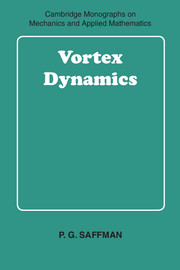Book contents
- Frontmatter
- Contents
- Preface
- 1 Fundamental properties of vorticity
- 2 Singular distributions of vorticity
- 3 Vortex momentum
- 4 Motion with surfaces
- 5 Some applications
- 6 Creation of vorticity
- 7 Dynamics of line vortices in two-dimensional flow
- 8 Vortex sheets in two dimensions
- 9 Dynamics of two-dimensional vortex patches
- 10 Axisymmetric vortex rings
- 11 Dynamics of vortex filaments
- 12 Three-dimensional vortex instability
- 13 Effects of viscosity
- 14 Miscellaneous topics
- Epilogue
- References
- Index
2 - Singular distributions of vorticity
Published online by Cambridge University Press: 05 August 2012
- Frontmatter
- Contents
- Preface
- 1 Fundamental properties of vorticity
- 2 Singular distributions of vorticity
- 3 Vortex momentum
- 4 Motion with surfaces
- 5 Some applications
- 6 Creation of vorticity
- 7 Dynamics of line vortices in two-dimensional flow
- 8 Vortex sheets in two dimensions
- 9 Dynamics of two-dimensional vortex patches
- 10 Axisymmetric vortex rings
- 11 Dynamics of vortex filaments
- 12 Three-dimensional vortex instability
- 13 Effects of viscosity
- 14 Miscellaneous topics
- Epilogue
- References
- Index
Summary
Vortex jumps
It has been supposed so far that the velocity and vorticity fields are continuous and have continuous derivatives. In a real viscous fluid, these assumptions are generally regarded as appropriate, and the velocity field is assumed analytic everywhere, except possibly at an initial instant o, when the speed of boundaries changes in a non-analytic manner. However, if we go to the the limit of vanishingly small viscosity and consider ideal fluids, to which the Helmholtz laws apply, the mathematics allows non-analytic behaviour and we cannot assert on physical grounds that only continuous fields should be considered. Velocity or vorticity fields with singularities or discontinuities are indeed of considerable importance. The singularities are, of course, not arbitrary and must be consistent with integral forms of the Euler equations or equivalently with the conservation of mass, momentum and energy. In particular, the dynamical constraint that pressure is continuous across a surface of discontinuity must be satisfied unless there are also singularities in the external force fields. We suppose in this chapter that the density is uniform and put it equal to unity unless explicitly stated otherwise. Also, external forces are supposed conservative unless non-conservative forces are explicitly introduced.
- Type
- Chapter
- Information
- Vortex Dynamics , pp. 20 - 45Publisher: Cambridge University PressPrint publication year: 1993

